Remember playing games as kids to see who could stay under water the longest? Although it’s probably been a while since you did it, how long do you think you could hold your breath? Think you’d be able to do it for the same amount of time when you add panic and confusion into the mix?
Imagine all the situations where air may quickly run out and you have no breathing apparatus to rely on. Whether you find yourself in a car that’s quickly submerging into deep water, a home consumed with smoke from a fire, or you’ve been exposed to a harmful aerosolized chemical, there are no shortage of ways you may suffocate or risk severe respiratory damage if you don’t know what to do. While gas masks or oxygen tanks might be nice to have under those circumstances, you may have nothing more to rely on than your own physical abilities.
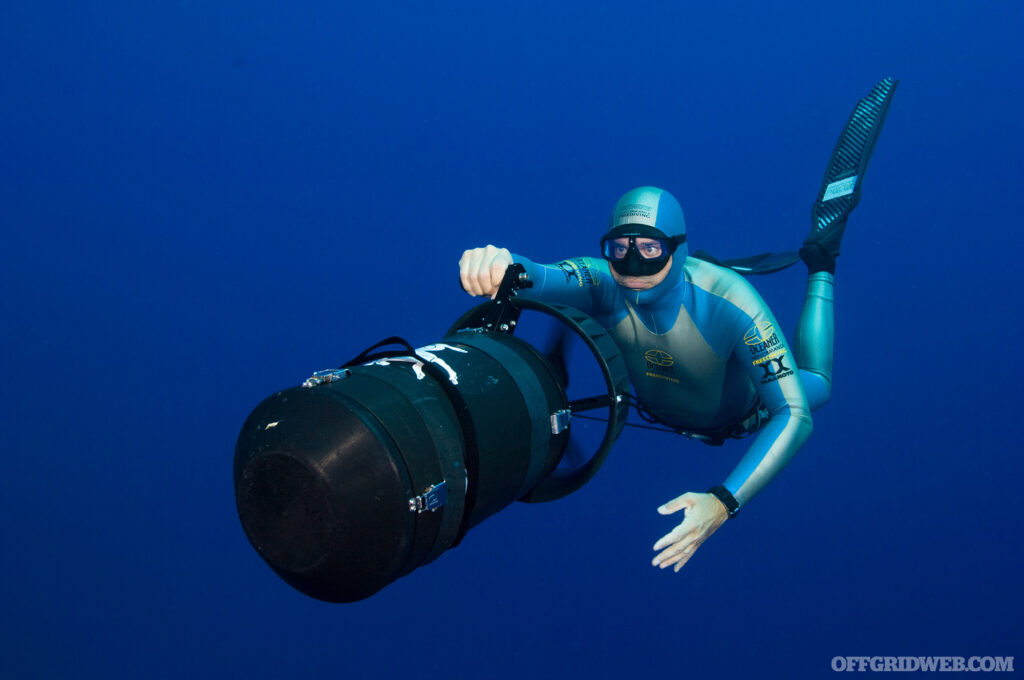
So, can you really train your body to hold your breath for prolonged periods of time? Yes. We spoke with Performance Freediving International owner Kirk Krack on how his company prepares people for these situations. Krack and his partner also started Aquatic Survival International to train military and government personnel. These techniques are just as applicable on land as they are to maritime environments. Having been tapped by James Cameron to provide training for the newest Avatar movie as well as military and law-enforcement units around the globe, Krack’s company helps others find skills they never knew could possibly save their life.
RECOIL OFFGRID: Tell us about your company.
Kirk Krack: I’m the founder and CEO of Performance Freediving International. I’ve been a water person all my life. I became scuba certified when I was 14, I’ve been a lifeguard, swim instructor, became a scuba instructor when I was 19, and bought my first dive shop when I was 20. I went all the way through the recreational scuba ranks, went into technical diving, and then eventually became a tri-mix instructor/trainer, so mixed-gas diving with multiple gasses (usually oxygen/helium/nitrogen) and scuba dives into the 575-foot range with six hours of decompression — all pretty extreme stuff.
Then, in the mid-to-late ’90s, I rediscovered free diving, which I’d always done. I got the opportunity to train a couple people to two national and two world records in the sport and realized there was no proper educational system around freediving. In January of 2000 I’d just left the Cayman Islands and started my next company with the idea of making a training system around freediving and breath-hold diving. Performance Freediving International is the world’s second oldest free-dive-specific training organization, but really we were the first to develop proper educational systems, standards, books, and everything like that.
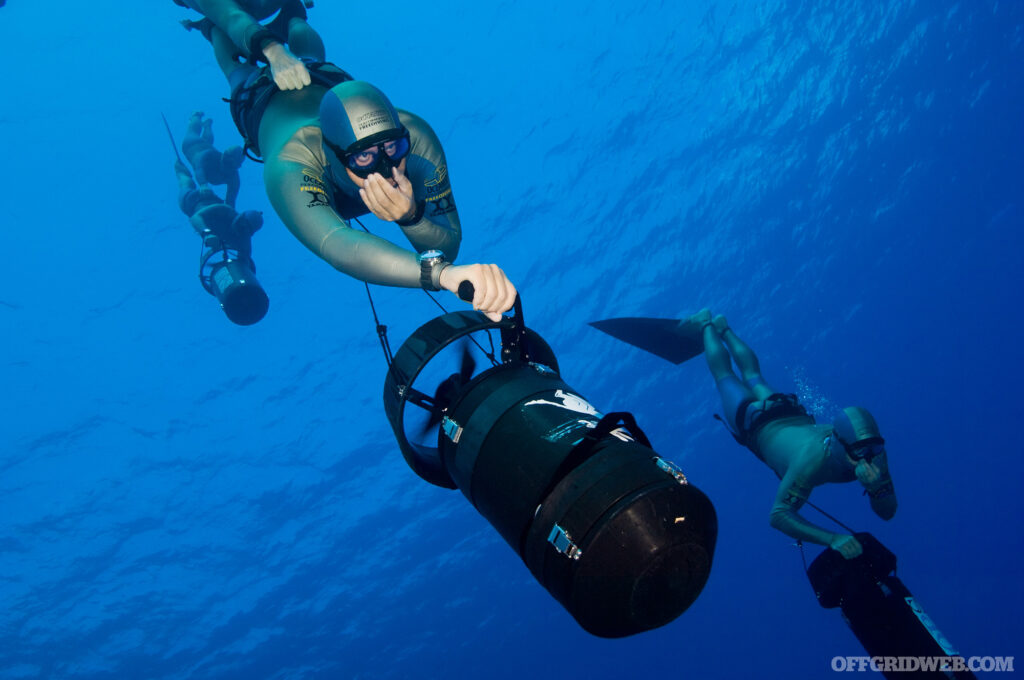
Above: Technical freediving is a type of breath-hold diving where the diver pre-breathes an enriched oxygen mixture to extend time underwater. (Photo by Courtney Platte)
Tell us about your curriculum and the courses you offer.
KK: We have both recreational and professional-level programs. Our recreational programs start at snorkeling and go into an entry-level, free-diver-level course, which is teaching people in the 20-meter/70-foot range. We have an intermediate free-diver program, which is into the 40-meter/130-foot range, and an advanced program where we’re teaching people to work as deep as 60 meters/200 feet.
We also have professional-level programs, so we teach people how to teach our system of education. Within the recreational side, we have a number of offshoot programs. One of them is called technical freediving, which is using enriched oxygen mixtures as a surface-breathing gas to increase safety, recovery, or extend breath holds. Another program we have is an adaptive free-diver program for working with people who have physical, mental, or learning disabilities, the premise of which is for everyone to be able to enjoy the underwater world.
We also have an offshoot called our breath-hold survival program. This is targeted at the recreational market that might need a breath-hold skill from a survival aspect for them being in the water. That could be kayakers, surfers, swimmers, that sort of thing. Then, we have another set of breath-hold programs that are aimed more at professionals, specifically special-operations members and it’s a breath-hold special operations program, so that’s dealing with intentionally stressed environments, where the risk and danger of that entrapment or equipment failure could be catastrophic and going to the surface is not the first or second option because they’re on missions.
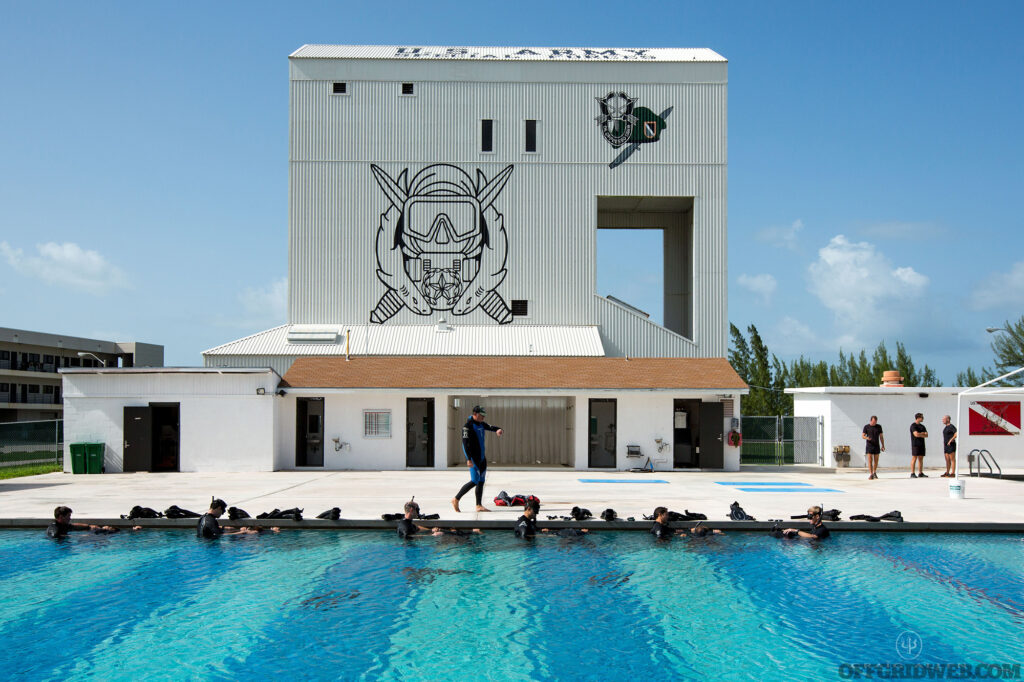
Above: Kirk Krack teaching diving skills to members of U.S. Army Special Forces. (Photo by Craig A. Gentry)
Can you tell me about some of the organizations you’ve trained?
KK: We’ve trained a number of organizations within the public safety area. We’ve trained Coast Guard rescue swimmers, Marine rescue units, and commercial diving companies. We’ve trained seven different special operations groups from three different countries. To give you an idea, we’ve done work with Air Force PJs, U.S. Naval Special Warfare Group, and several others along those lines.
As far as your recreational survival training, give us an example of how that could be useful.
KK: A really good example of how our program was born was working with big-wave surfers. We were approached by Red Bull to design a program — we already had something in the pipeline and had been playing with it and teaching some people. Red Bull approached us to teach a big-wave surfer named Ian Walsh, who at that time had surfed some of the largest waves in the world, about 80 feet. Ian was a great surfer, but his breath-hold abilities needed some work. He said that when he was under water, his ears hurt because he didn’t know how to equalize and so we developed a five-day program with the idea that when you’re on big waves you could experience a multiple-scenario hold-down.
What we try and train for is the three-wave hold-down where you’re under the water for a minute. It’s a very violent minute because you probably didn’t get a great breath hold and also got the wind knocked out of you, then you’re in a high metabolic rate. You only get about 15 seconds once you get to the surface, and you’re released before the next wave hits you and you’re held down for that next minute. We repeat that three different times with only about a 15-second interval. During that time, we create a stressed environment that the person works in.
What we’re trying to do is teach people the techniques and realities of breath holding. How the physiology and physics works with it, and what the psychology is behind it. We try and train a system of inducing mammalian diving reflex, and some of those reflexes, for example, are inducing bradycardic response, which is a slowing of the heart. The heart is a significant muscle in the body and consumes oxygen as it’s pumping blood through the circulatory system. The faster and harder it pumps, the more it’s moving it into the extremities of the circulatory system.
Another diving reflex we work on is creating splenic contractions. The spleen is a reservoir for hemoglobin that’s being processed out of the body but still has oxygen-carrying capacity. We can train the spleen to shrink by 20 percent, pushing more red blood cells into the circulatory system, so it’s almost like a natural form of blood doping. And then there’s other systems we change. We change the body’s ability to handle more carbon dioxide, which allows the breath hold to be more relaxed and go longer with less stress.
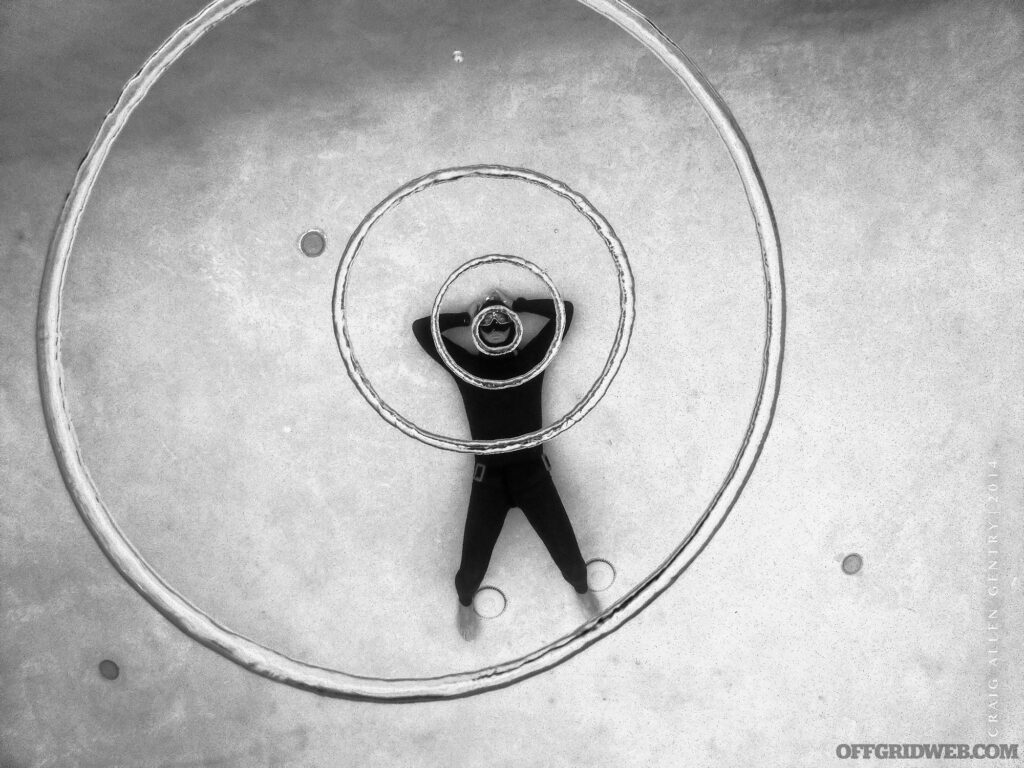
Above: Krack blowing rings underwater. (Photo by Craig A. Gentry)
Are there a few basics you think all people should know for an emergency?
KK: Absolutely. We’ve worked with fire departments, marine rescue units, police dive recovery teams, but within the fire departments, they work in noxious environments, so that’s one thing. Any time you’re working in or playing around the water where there’s potential entanglements or entrapments, currents, rivers, and so on, you should have an understanding of the survival aspect of breath hold. It’s one thing to have a breath hold, but if you’re so preoccupied in the breath hold that it takes away from your ability to problem solve, then that’s not going to help you.
Once you develop a breath hold, then you try to develop a working breath hold where, during that time, you can problem solve: puzzles, knots, stuff like that. You can slowly work yourself out of the situation, keep rational thought, and remain calm. Being able to remain calm is important. When you’re calm, your metabolic rate is slower, so your consumption of oxygen is going to be reduced and therefore the creation of CO2, the waste product that the body creates, is going to be minimized, which actually gives you that urge to breathe, so you’ll extend your overall bottom time. By slowing down and stopping and thinking you can initiate the logical problem-solving aspect to get yourself out of that situation.
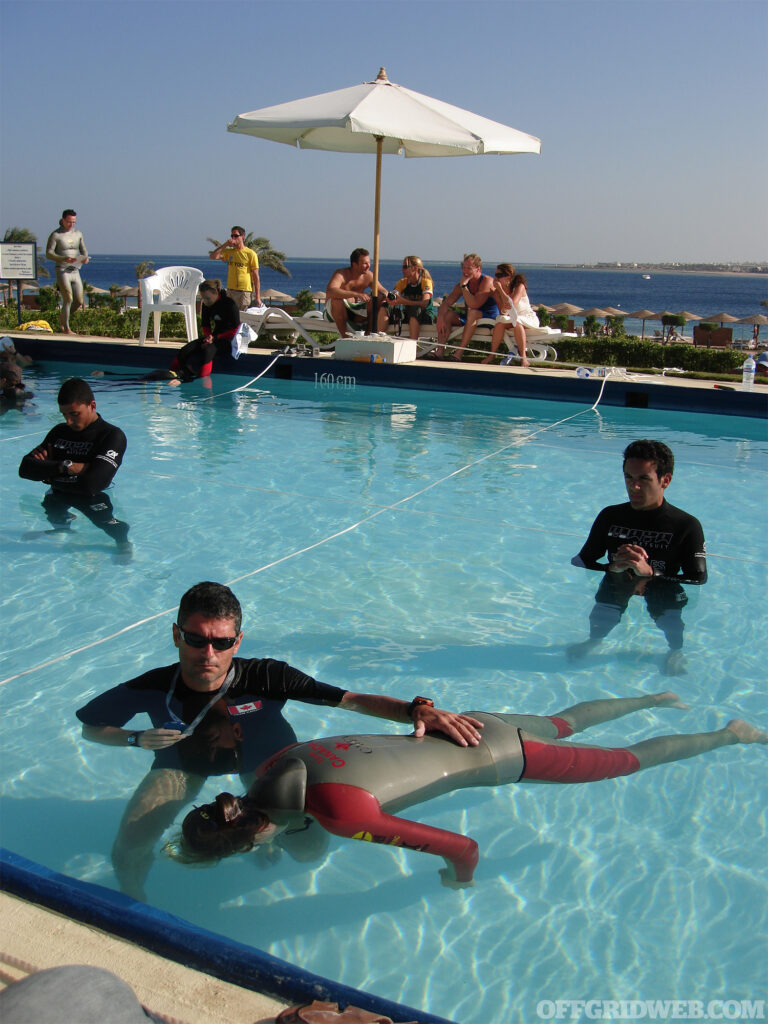
Above: Krack coaching Team Canada's Mandy-Rae at World Championships in Egypt.
What do you think the best ways are to mitigate stress in these kinds of situations?
KK: We use this in all diving programs, that when presented with a situation, we call it “Stop, Breathe, Think, and Act.” That’s from a scuba point of view because the second thing is breathe, however, from a breath-hold situation, it’s “Stop, Think, and Act.” At some point you have to resist moving into the panic cycle. By taking that split-second to stop and evaluate your environment, stop your physical activity, and let yourself adjust to what’s happening, you can put your resources into working your way out of the situation. Working through it in a methodical way and at a pace that’s calculated and slow to conserve oxygen gives you more time to problem solve.
Now there’s skills with that. You could find yourself in a situation, like if your car hits the water and it’s slowly going under and filling with water. We know that trying to open the door when there’s water on the outside and air on the inside, the water pressure just forces it shut. Knowing that, you have a short but adequate period of time to get ready for the situation. In a very short period of time, everyone has the ability to hold their breath for a minute or longer if they’re relaxed about it; a trained individual will be able to last longer.
In that short period of time, in a relaxed way, we want to get rid of as much CO2 from our lungs as we can so that will allow us to have a longer breath hold in which to work ourselves out of the situation. We can do this by what we call purging or hyperventilation breaths. They’re deep, forceful breaths, but not excessively fast. Think of it as if you have a candle about a meter away and you’re taking a breath into the full lung and you’re trying to blow that candle out, not sharp and quicky, but long. So it’s about 1 second into full breath, and then about a 4-second relaxed full exhalation and we can repeat that about five times.
And the final thing we want to do is, just before that last breath is going to come and we’re remaining calm, is take our last breath. It’s called a peak inhalation, and we take our breath from the bottom of the lungs to the top: nice, easy, and relaxed. That breath takes about 2 seconds to take in, fills to the top, and then you swallow so that you’re holding the air in the lungs, but the lungs and chest are relaxed, not feeling like you’re holding it in at the lips with your cheeks about to explode. So we relax the chest and the stomach because tensed muscles consume more oxygen. We swallow to close that air off and hold it in at the throat.
It’s like blowing up a balloon and you’re holding that air inside the balloon by pinching the opening closed versus holding the wall of the balloon open to keep that volume in. And then the throat lock keeps that air in so the rest of the body will be relaxed. For example, I can be doing a breath hold in the pool and everything is nice and relaxed, but if I start to get cold and get my first shiver, my resting oxygen consumption has gone up 500 percent because now every muscle fiber is going to try to shake to create heat.
Think of it like a fuel tank in a car. I can be at idle in a parking lot with the car on and idling at 500 to 600 rpm or I can be stepping on the gas while still in park and revving it at 3,000 rpm. That’s what shivering does. If I’m just a little bit tensed, even if I’m not moving my arms and legs, I’ve gone from 700 to 3,000 rpm. Then, if I’m actually doing work like moving and flailing around because I’m panicked, now I’m at 5,000 rpm. What we’re trying to do is say that you have a limited amount of gas, and in a survival situation, you’re not going to be at 700 rpm because you actually have to problem solve and move yourself out of the situation, but you can be at around 1,500 rpm so your metabolism is low and slow. You’re not consuming the gas, but you’re certainly not at 5,000 rpm.
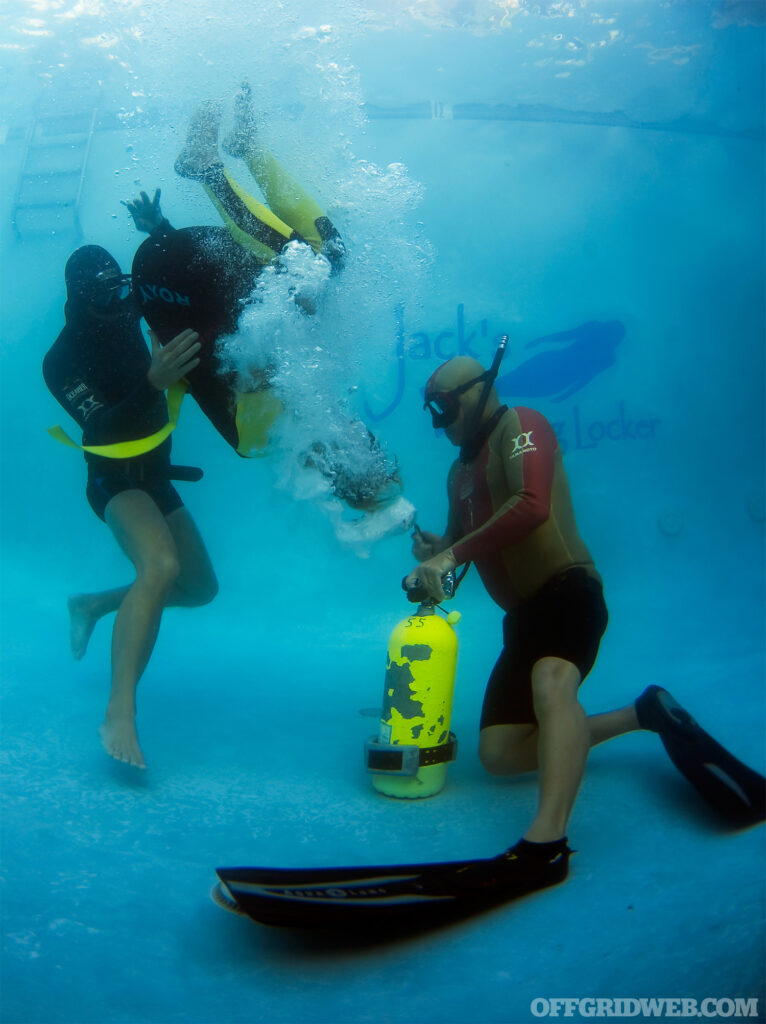
Above: Surf Survival photo of Krack and Craig A. Gentry training a pro surfer. (Photo by Brian Bielmann)
How do you think breath control changes on land versus in the water?
KK: A breath hold on land versus water are two different things. For some people, it’s the psychology of it. Some people will be able to hold their breath longer on land than in water, when in fact the water should give you physiological advantages. That simply comes down to the psychology of it. A person feels that on land they can hold their breath right to the very last second and they’re not at risk. Whereas, once you’re in the water and that water is surrounding your airway, then at that point you know you’re compromised and there’s a risk.
If you can get the majority of your focus on the problem at hand, then you’re going to make good, rational decisions in a sequence that’s going to solve your problem. In our programs, we can inoculate you from the fear of being in the water so you can understand your capacity in the water on a breath hold and also in a stressed environment.
By the time you come out of the program you’ll have done breath holds over 4 minutes, sometimes people in the 5- to 5 ½-minute range in what we call a static environment where you’re not moving and holding breath for a maximum amount of time. Then, we create a stressed environment. To give you an example, if we can do 4 minutes in a static environment, in a moderate workload environment, we can take about half that away. If you’re a free-diver with a 4-minute static breath hold, if you were to do moderate work and get down to the reef to have a little fun, then you’ve got about half that time.
If we put you in a survival situation where everything is working against you and you have not only a high metabolic state, but you’ve got caught on exhalation, then you’ve got a quarter of that fuel tank left. Say if you had an equipment failure during a scuba exercise or were surfing and got the wind knocked out of you, then in that worst-case scenario, out of that 4 minutes you don’t have half anymore. You’ve got about a quarter of that or a minute at that point of what we’d call a working breath hold — one where you can problem-solve yourself out of the situation.
To train for a high metabolic environment, I have you exhale, put you under the water, and I give you a slate of 10 questions. You’ve got to read and answer the questions. For the first minute, you’re probably good, but after that minute you probably can’t even read the questions, let alone think about them and write the answers down. So, while you might be surviving, you’re not problem-solving yourself out of the situation. Ultimately, what we’re trying to do is create the biggest static breath hold that we can and then inoculate you into the stressed environment to make that survival breath hold the longest.
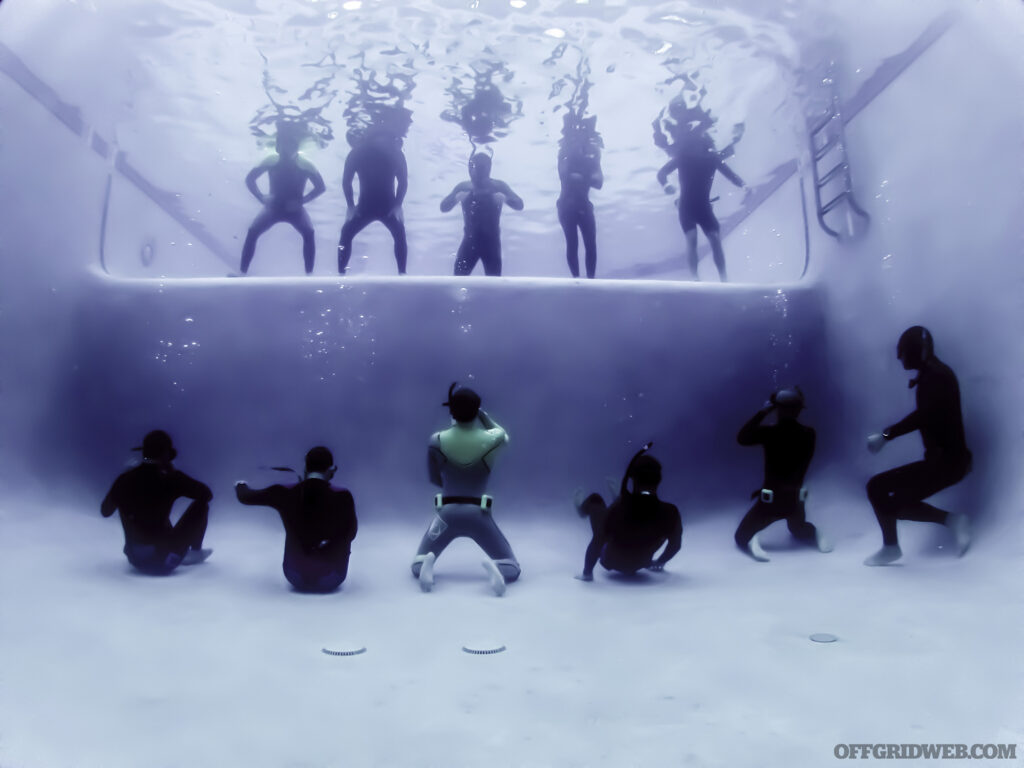
Above: Training a group of top big wave surfers. (Photo by Craig A. Gentry)
Are there certain things you think most scuba certification courses neglect to train that your program does train?
KK: A typical recreational scuba course will really spend no time on breath-holding skills at all. You’ll maybe get 15 minutes to practice in a pool. They’re inadequate in teaching good equalizing techniques. Really what they’re trying to teach you is to be under water where you have ample supply of air on demand and how to deal with that situation. But what do you do when you have complete equipment failure, you don’t have a buddy, or you have entanglements? That’s where breath-hold survival training can really take you to the next level for that person who might find themself in those situations.
Have you had any feedback from clients who’ve been in that kind of situation and used this training to save their life?
KK: We trained Ian Walsh, who I mentioned earlier, several years ago. A few months later, I got a text from him. It wasn’t so much a survival situation, but he was at Jaws [a nickname for Pe‘ahi, a beach on the north shore of Maui known for extremely large waves]; he lives just down the road from there. One of the Jet Skis he was on crashed, and he was just hanging out in the water watching. Normally, with Jaws, the Jet Ski tows you in because it’s too dangerous to paddle out there. He’d been using the training, had this great breath hold and thought, “Screw it, I’ll just paddle in.” Really it was one of the defining moments in surfing, because at that point, that was one of the catalysts that brought in the new form of big-wave surfing: paddle-in surfing.
Whenever we teach the special operations groups, like SEAL Delivery Team 1, Naval Special Warfare Development Group, and a number of groups like that, by the second day they’ve done some pretty awesome stuff — things they didn’t think were possible. They really started to open up and one of the things they told us is that they should’ve had this training before they were even shown a scuba system. Yet, within the military, it’s maintained as a very equipment-oriented training and application. They haven’t had a program built around the breath-hold aspect of it.
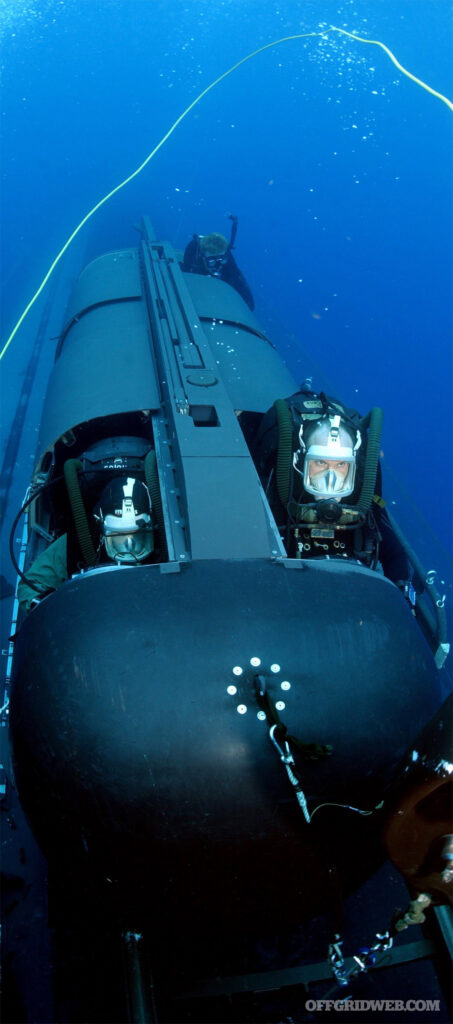
Above: Advanced diving equipment is helpful, but Krack believes that it should always be supported by an underlying level of breath-hold survival training. (Photo courtesy of U.S. Department of Defense).
What do you think the biggest risks are in training these techniques?
KK: I’m glad you asked that. We have to understand that in breath-hold survival training, you are routinely holding your breath and stressing your body. To get gains and build capacity, we have to stress the body. Just like physical training, if I want to build muscle, I’ve got to go to the gym, break the muscle down at the gym, and then it’s going to repair and over-repair itself for next time.
The same thing happens in the training that we’re doing. We need to stress the body repeatedly, such that we can develop capacity and force the body to change. But because we are doing breath holds, we are putting ourselves into hypoxia — a varying degree of lack of oxygen. Hypoxia can eventually lower our oxygen in the body and cause loss of motor control and lead to blackout, which is not uncommon.
Understand that we always train breath holds with a properly trained buddy who provides direct supervision. No one should be practicing breath holds unless they’ve gone through the training. They shouldn’t be practicing breath holds unless they’re practicing with an equally trained buddy because it’s not the blackout that kills you, it’s the drowning that ensues right after that.
It’s not uncommon that people in training get to the point in their breath hold that they’re unable to help themselves and that’s when their buddy steps in and assists them. No harm, no foul, and if done properly it’s a learning experience. That session is done for the day — try it again the next day and learn from your mistake. But practicing breath holds without someone equally trained who’s there to protect your airway or lift your head out of the water is very dangerous. We also don’t practice dry breath holds while doing something like driving a car or while walking in areas that could be unsafe. That would be the biggest risk.
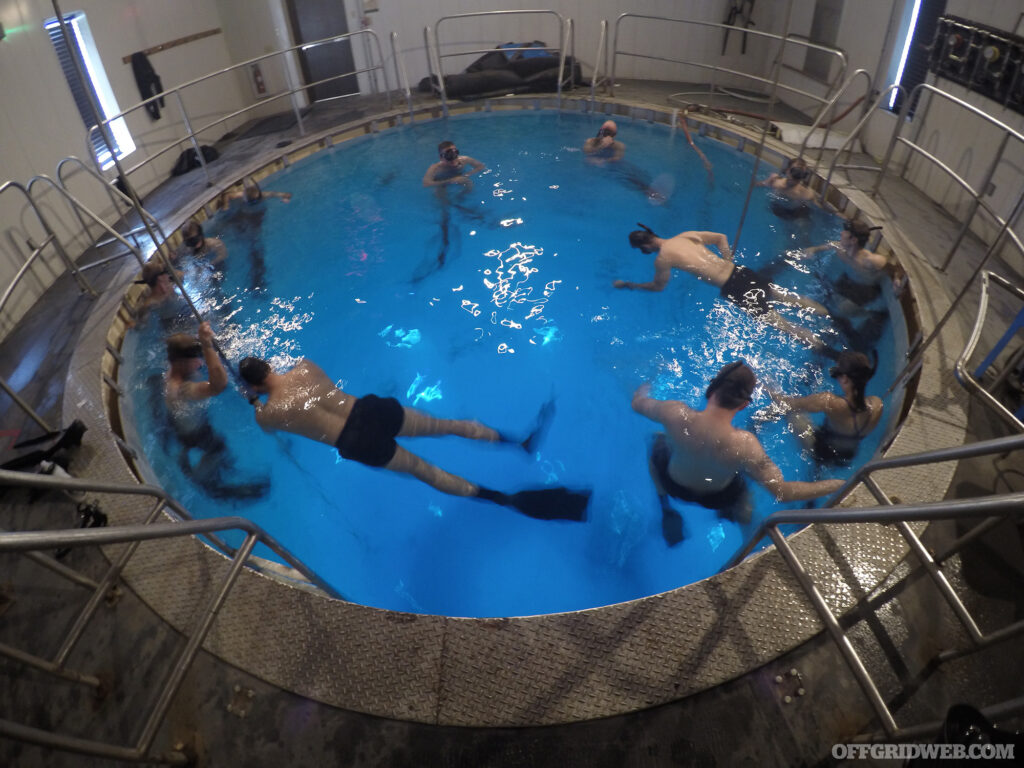
Above: Krack teaching U.S. Army Special Forces in their 50-foot deep tank. (Photo by Craig A. Gentry)
What are some of the biggest rookie mistakes people make during training?
KK: Not understanding the proper breathing cycle, being too aggressive, and not taking enough time.
Are there any prevalent misconceptions people have about the training prior to taking it?
KK: I think the misconception among the general public is that we’re holding our breath and that kills brain cells. If you’ve taken a first-aid course, everyone knows that if the brain goes without oxygen for 4 to 6 minutes, irreversible brain damage can occur, but that’s when they’re in a state of anoxia — a complete lack of oxygen. In breath-hold training or a breath-hold survival situation we’re holding our breath, but we have ample oxygen. We’re simply going through hypoxia, a varying degree of oxygen. I could be in that state of slowly decreasing oxygen for 4 to 6 minutes and then, even when I black out, I still have oxygen in my system. I could still have a couple minutes of oxygen and then after I’ve blacked out, then I’m hit with an anoxic situation. So, at that point I’ve got 4 to 6 minutes before I start to have irreversible brain damage.
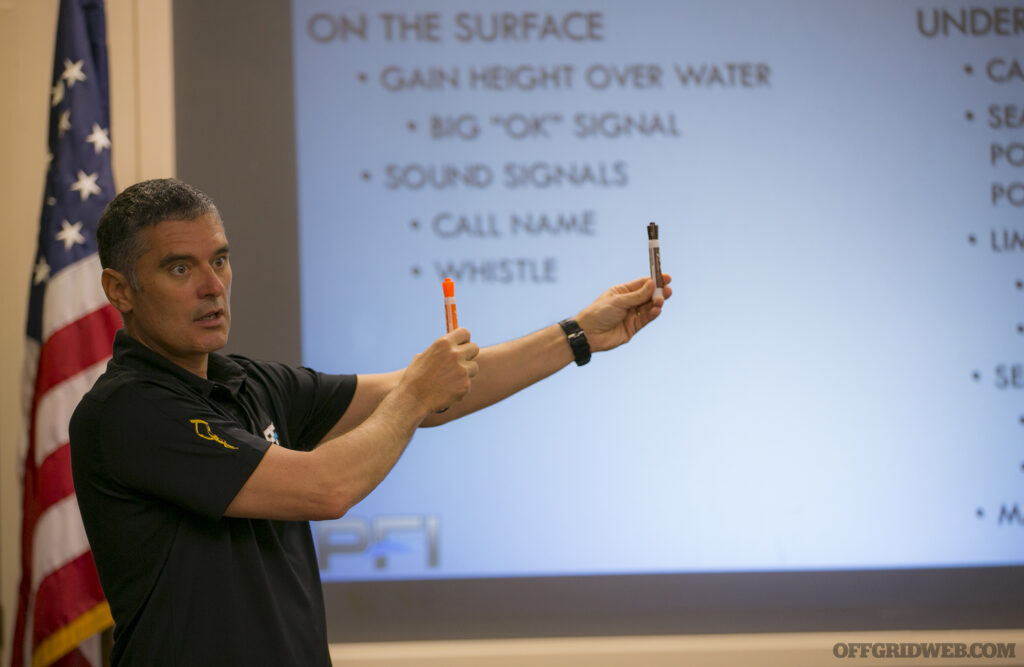
Above: Krack discussing survival breathing concepts in a classroom.
How long do your courses run for?
KK: Our breath-hold special operations program runs for five days, and our recreational breath-hold surf survival programs typically run four days.
What do you think people should know before they enroll in one of these courses?
KK: It’s going to be great learning. They’re going to be taxed and bump up against very primal fears. Our fear of falling, our fear of being eaten, and our fear of suffocation are primal fears, and there’s a lot of soul searching that way. We really test who a person is and their resolve, but ultimately, they come out having accomplished very incredible things, learning a lot, and providing invaluable tools in their toolkit, especially if they work in an aquatic environment where there could be risks they need to get themselves out of.

Above: Technical freedivers use sea scooters to dive close to the ocean floor.
Sources
Performance Freediving International
Aquatic Survival International
Related Posts
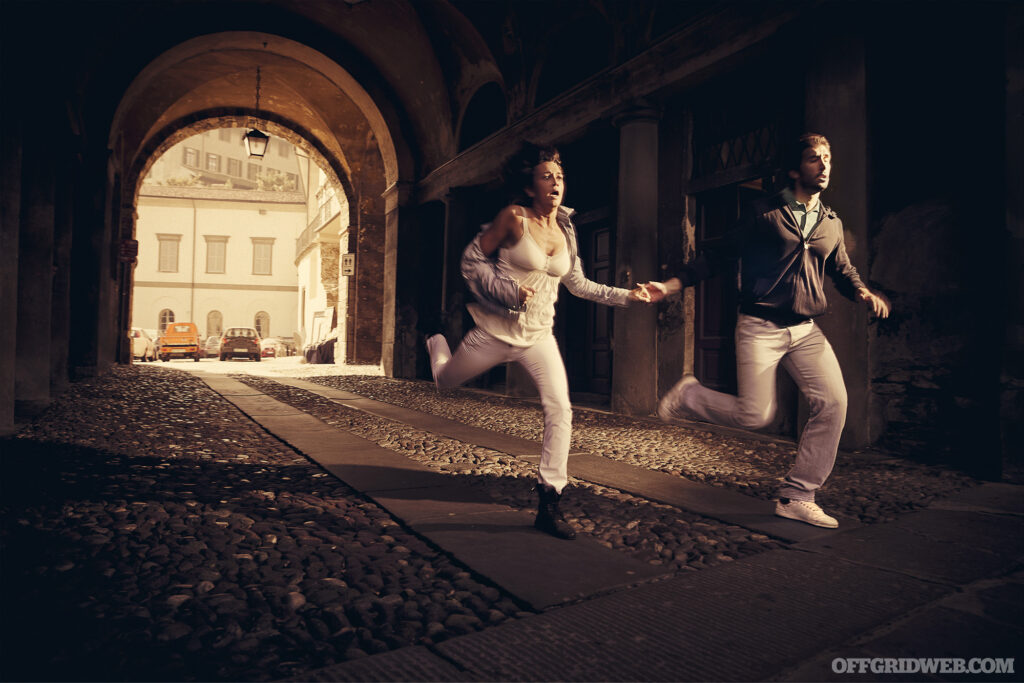
Be Cool: How to Hold it Together in the Face of Deadly ThreatsSomeone telling you to "be cool" is easy, but it's much more challenging in practice. Here are some ideas to help stay frosty when it counts.
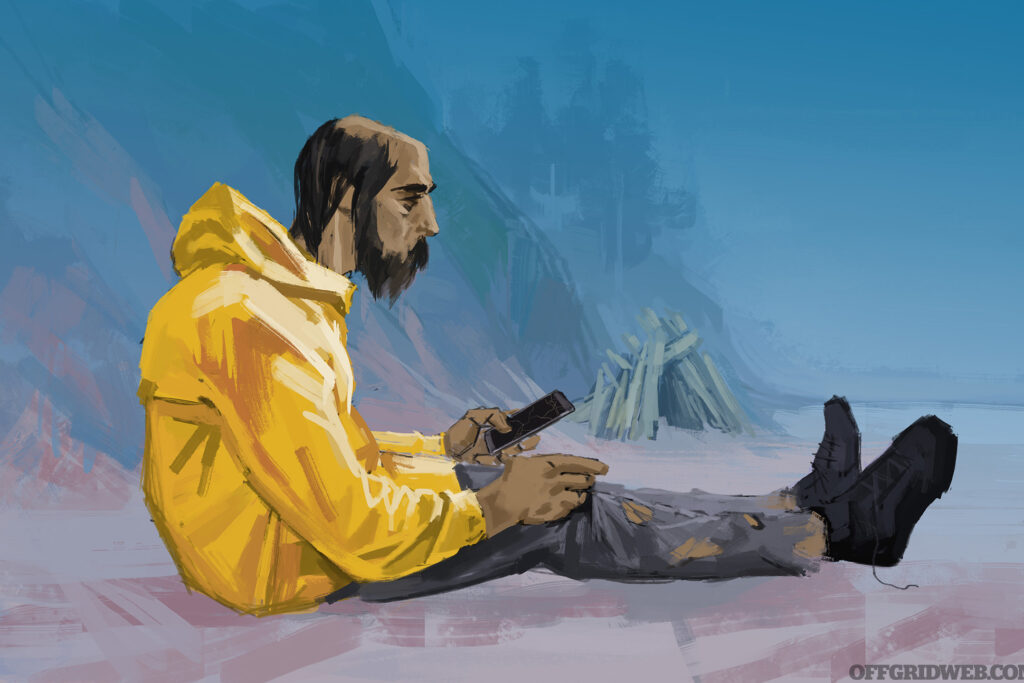
What If You’re Isolated for an Indefinite Amount of Time?What would you do if you’re suddenly thrust into a situation where you face indefinite isolation after being left stranded in the wilderness?

Building Rapport: Tips on Working with Foreign PopulationsSurvival isn’t an easy game. It gets exponentially more difficult when you find yourself surrounded by a population that speaks a different language, eats different food, with different […]
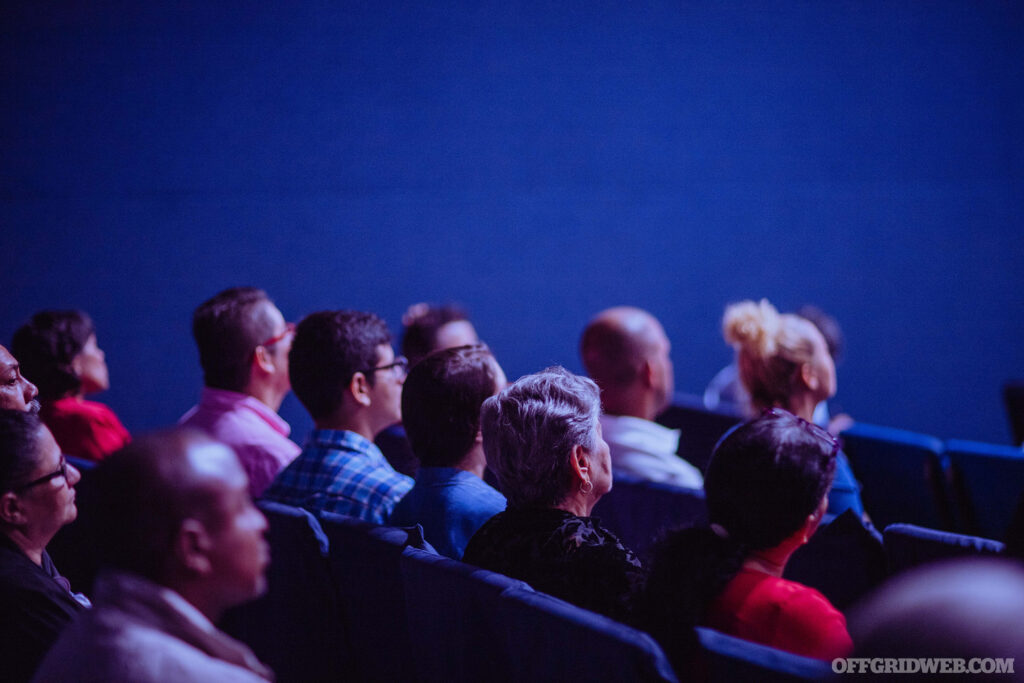
The Final Weapon: John Hearne LecturesIntroducing John Hearne
Most of the training events we cover in this column are courses on how to shoot — whether it’s long-range shots with rifles, fast strings with pistols, or how to […]
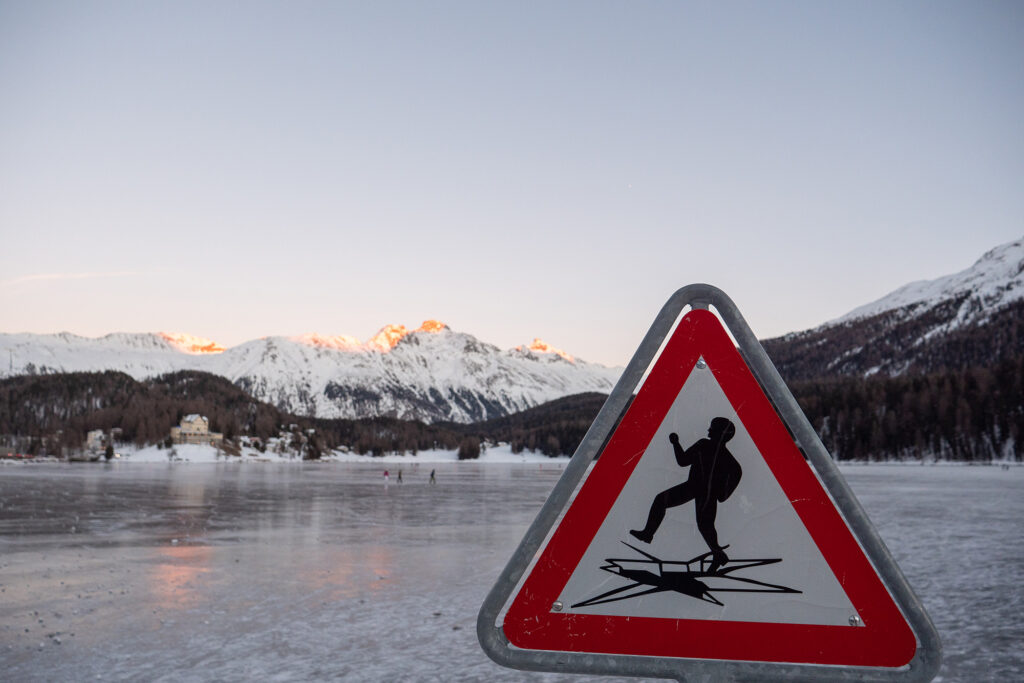
Cold Water Safety: Avoid Common Mistakes in Freezing TemperaturesRapid immersions in cold water are dangerous and can quickly become life-threatening if not prepared. We discuss what you can do to increase your chances of survival.
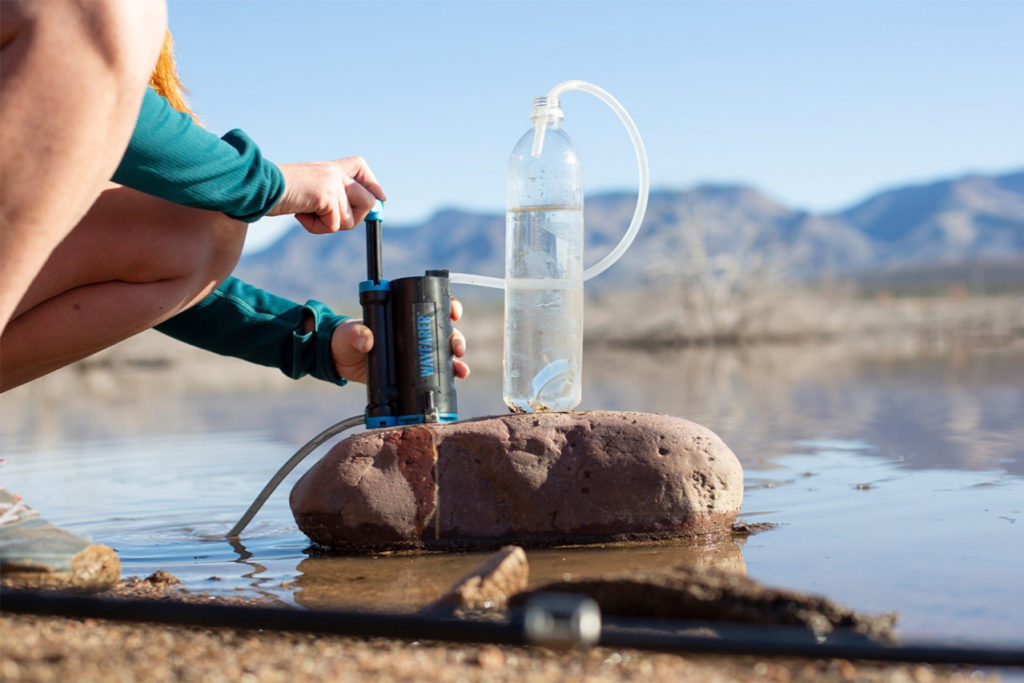
New: LifeSaver Wayfarer Compact Water PurifierThe LifeSaver Wayfarer water purifier is designed to fit easily into a pocket or small backpack, and weighs only 11.4 ounces.

Stimulants: The Pros and Cons of Tea, Coffee, Tobacco, and MoreSome performance-enhancing stimulants may find a place within your emergency preparedness plans, but others are dangerous or addictive.
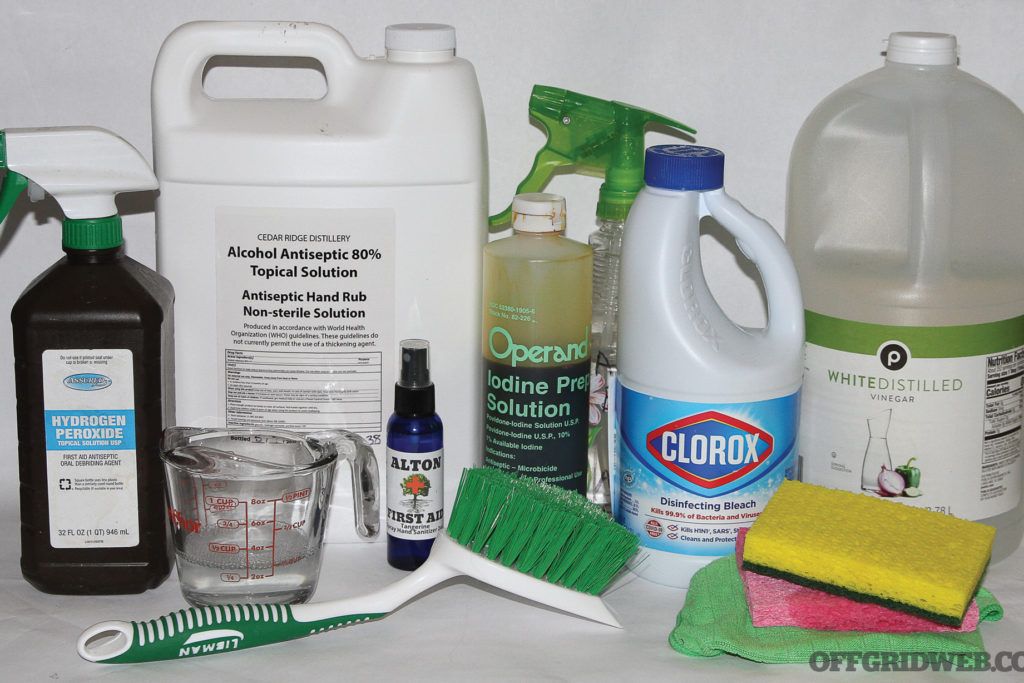
DIY Disinfectants: How to Fight Diseases with Limited ResourcesStrict attention to hygiene and use of disinfectants, both off-the-shelf and improvised, will save many lives in the aftermath of a disaster.

Transitional Food Preps: Staying Fed Between Storage and CultivationStoring food for emergencies is only the first part of transitional food preps that will help keep hunger at bay.
The post Save Your Breath: How You Can Learn Lifesaving Survival Breathing Techniques appeared first on RECOIL OFFGRID.
By: Patrick Diedrich
Title: Save Your Breath: How You Can Learn Lifesaving Survival Breathing Techniques
Sourced From: www.offgridweb.com/survival/save-your-breath-how-you-can-learn-lifesaving-survival-breathing-techniques/
Published Date: Tue, 30 May 2023 11:00:51 +0000
-------------------------------------------------------------------------
 CampingSurvivalistHuntingFishingExploringHikingPrivacy PolicyTerms And Conditions
CampingSurvivalistHuntingFishingExploringHikingPrivacy PolicyTerms And Conditions
